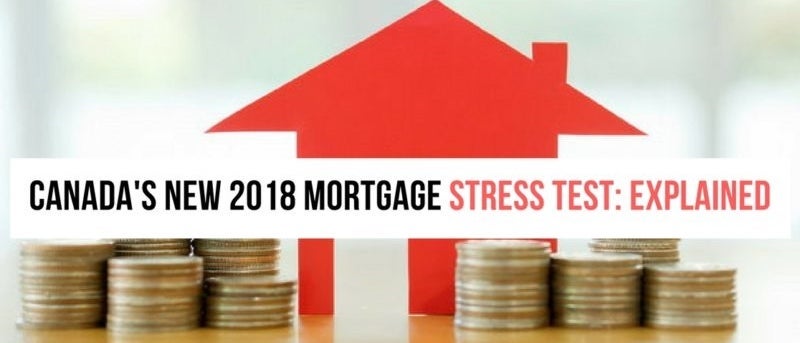

Brenda Upton from Dominion Lending Centres breaks down the new changes to the mortgage space:
Come Jan. 1, 2018, Canadians getting, renewing or refinancing a mortgage (Including non insured mortgages) must now prove that they would be able to cope with interest rates substantially higher than their contract rate by using a new minimum qualifying rate.
New rules by Canada’s federal financial regulator announced in October mean that even borrowers with a down payment of 20 per cent or more will now face a stress test, as has been the case since January of 2017, for applicants with smaller down payments who require mortgage insurance.
Ottawa has already moved to tighten the rules around the mortgage market six times since July 2008, with a series of regulatory tweaks aimed at limiting the amount of debt that Canadians and financial institutions take on.
This is the seventh turn of the screw — and it could have a big impact.
Some 10 per cent of Canadians who got an uninsured mortgage between mid-2016 and mid-2017 would not have qualified under the new standards, a recent analysis by the Bank of Canada suggested.
CHANGE 1:
QUALIFYING RATE STRESS TEST TO ALL NON INSURED
Non insured mortgage consumers (buyers with a 20% or greater down payment) must now qualify using a new minimum qualifying rate. The minimum rate will be the greater of the five-year benchmark rate published by the Bank of Canada OR the lender contractual mortgage rate +2.0%.
How does this affect the mortgage consumer with a down payment of 20% or more?
The biggest impact will be on the amount in which the homebuyer will be able to qualify. Previously, the homebuyer qualified at the rate offered by the lender. Now, the homebuyer must qualify at the benchmark rate which is the higher of the Bank of Canada Rate (currently 4.99%) OR the rate from the lender plus 2%. This applies to all terms, fixed and variable rates.
 The stress test for non-insured mortgages applies to both fix rate and variable rate mortgages.
The stress test for non-insured mortgages applies to both fix rate and variable rate mortgages. On variable rate mortgages, the rate at time of funding is based on Canada’s prime rate (presently 3.20%) +/- a given margin. Today’s average variable rate is prime - .45% (3.20% is prime – 0.45%) = 2.75%. So applying the stress test of the greater of the two qualifying rates; Bank of Canada is 4.99% and the actual rate of 2.75% + 2% = 4.75% thus the BOC would be the qualifying rate to use since its higher.
LISTEN: Tasha Kheiriddin discusses the new mortgage rules
What if I don’t qualify at best rate lenders?
The qualifying stress test rule will also apply to alternative lenders (also know as B lenders) who are governed by OSFI. Any federally regulated lender will have to adhere to the stress test ruling. This will be all mortgage lenders in Canada excluding private lenders and Credit Unions.To counter this much higher qualifying rate, these alternative lenders will have the discretion to revisit their own income-todebt-ratio (TDS) calculation policies. For example, presently these alternative lenders have the ability to approve mortgages with a 50% TDS (banks are more like 42% on average). Under the new stress test rules, alternative lenders will most likely have to increase the TDS policy to a higher figure to offset the higher qualifying mortgage payment under the stress test rate calculation. DLC will communicate to our network as soon as lenders are able to communicate their decision.
CHANGE 2:
LENDERS WILL BE REQUIRED TO ENHANCE THEIR LOAN TO VALUE (LTV)MEASUREMENT AND LIMITS TO ENSURE RISK RESPONSIVENESS
Mortgage lenders (excluding credit unions and private lenders) must establish and adhere to appropriate LTV ratio limits that are reflective of risk and updated as housing markets and the economic environment evolve. We are awaiting more details on this policy from lenders. As we have new information, we will update this document.What does this mean?
OSFI directs lenders (excluding credit unions and private lenders) to have internal risk management protocols in higher priced markets (sometimes called “hot real estate markets” like Toronto and Vancouver). This is a continuation of a policy already in place. Many mortgage lenders have been following the principles of the policy for the last 10 to 12 months.CHANGE 3:
RESTRICTIONS WILL BE PLACED ON CERTAIN LENDING ARRANGEMENTS THAT ARE DESIGNED, OR APPEAR DESIGNED TO AVOID LTV LIMITS
Mortgage lenders (excluding credit unions and private lenders) are prohibited from arranging with another lender: a mortgage, or a combination of a mortgage and other lending products, in any form that circumvents the institution’s maximum LTV ratio or other limits in its residential mortgage underwriting policy, or any requirements established by law. This is often referred to as “bundling” or “bundle partnership”.What does this mean?
For example: a consumer applies for 80% LTV mortgage and the lender can only approve 65%. The lender then partners with a second lender for the additional 15%. The original lender then “bundles” the 15% LTV mortgage with the original 65% mortgage to form the complete 80% LTV loan. This is no longer permitted as per OSFI.STRESS TEST SUMMARY:
UNINSURED MORTGAGESHome buyers/owners qualify for a mortgage using the benchmark rate, which is the Bank of Canada rate (Now 4.99%) OR the lender rate +2%, whichever is greater.INSURED MORTGAGESYou must qualify for a mortgage at the Bank of Canada rate (currently 4.99%).
TO CLARIFYThe new stress test - the greater of BOC rate OR actual lender rate +2% - only pertains to uninsured mortgages where your equity is 20% or greater.
DOES THIS AFFECT AMORTIZATION?This new policy from OSFI does NOT have an amortization component. The lender can still set the qualifying amortization to their own specific policy (eg, 25, 30 or 35 years).


For more information regarding these rule changes feel free to contact Brenda Upton:
Phone: 250-295-5411
Email: brenda@clearmortgage.ca
